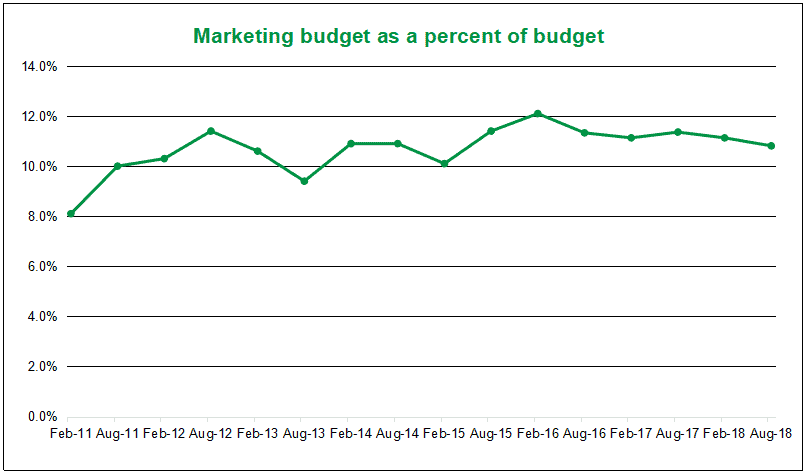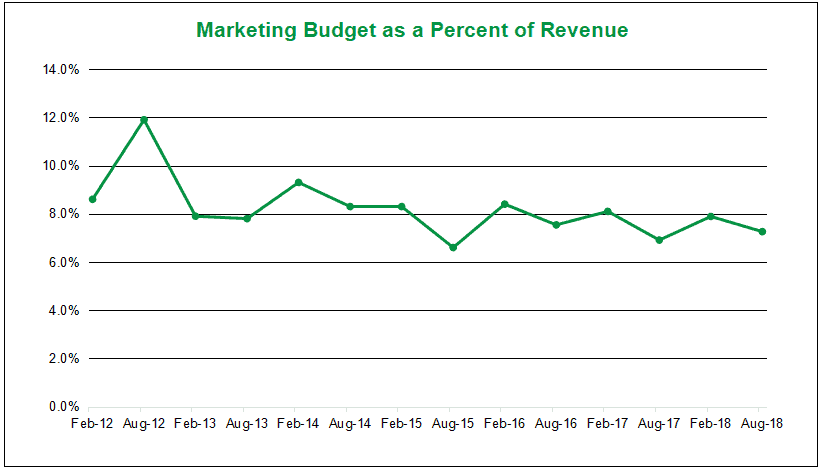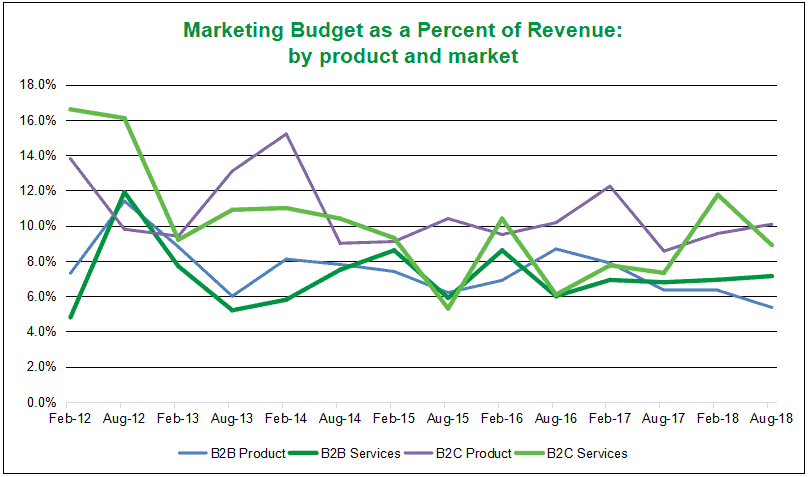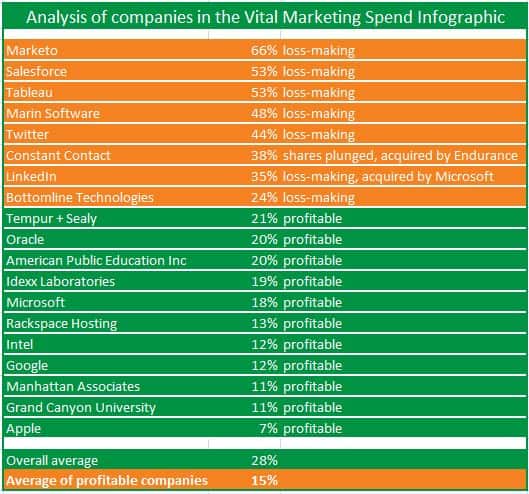No doubt about it, marketing is expensive. And there are plenty of agencies out there who’d like to help you spend your money! But how do you determine your marketing budget?
There’s no one answer to that question. But there are some common approaches to setting a marketing budget. I’ve listed them here, with research to support the answers wherever possible.
[NOTE: this post relies heavily on CMO Survey research data. The CMO Surveys from Feb 2019 onwards do not collect the relevant data. So our 2019 update will be the last update to this post. Unless someone has an alternative credible data source – if that’s you, please let me know!)
1. Your own business budget history
It’s always good to start from what you know.
If you’ve been spending a certain amount on marketing and you’re happy with the results, by all means use that same formula for the future.
But what if you’re not happy with your marketing results?
- Is it because your marketing budget is too small?
- Or is it because your marketing budget isn’t delivering how it should?
Before increasing the amount you spend on marketing, you might want to sanity-check against one or more of the following methods.
2. Set your marketing budget as a percent of your total costs
This seems like a great place to start. When you’re creating or reviewing a budget for the next 12 months, it’s an ideal time to sit back and look at the big picture.
This chart from the CMO Survey shows marketing budget as a percentage of total budgeted costs over time. (Unfortunately they stopped asking about budget setting in 2018, so there’s no more recent data.)
You can see the amount of budget allocated to marketing has been increasing steadily, from 8.1% in 2011 to 12.1% in 2016.
At the very least, this gives a ballpark idea of how much you might want to spend. Be aware, however, that survey respondents are mostly larger, established companies. As detailed later in this post, that makes a difference!
A word of caution
The CMO Survey figures are very unclear about whether the ‘marketing budget’ includes the people-related costs of the marketing team, or whether it’s just money allocated to external suppliers. I tend to believe the budget includes both.
What does that mean for you?
When you’re budgeting, include the time you spend on marketing as well as the money you spend on budgeting.
Set a rate per hour for whoever is doing marketing and estimate how much time it’s taking them. Even better, ask these people! (If it’s not all you.) Getting a clear picture of your time investment is helpful for more than budgeting. It can also be a great way to identify options for productivity improvements.
3. Set your marketing budget as a percent of revenue
This is probably the most widely used method of comparing marketing budgets.
The CMO survey also had an answer for this question. They got an average of 7.5% in 2019. The trend is for about 7-9% of revenue to be spent on marketing.
But the story is a bit more complicated.
4. Check how your marketing budget compares to similar companies
It’s all a question of which companies are included in the statistics. Thank goodness, those lovely people at the CMO survey understand that. They’ve actually broken down their data in a number of ways.
B2B vs B2C / Products vs Services
I mentioned the data in the top right of the previous CMO Survey charts. It breaks the data down by what the company sells, and to whom. (They also have an industry-specific breakdown if you dig deep into the results.)
The last figures available (August 2018) show that
- B2C product businesses spend 16% of budget and 10.1% of revenue on marketing.
- B2C service businesses spend 14.9% of budget and 8.9% of revenue on marketing.
- B2B product businesses spend 9.2% of budget and 5.4% of revenue on marketing.
- B2B service businesses spend 8.9% of budget and 7.1% of revenue on marketing.
It’s immediately obvious that businesses selling product to consumers have the heaviest investment in marketing. Consumer services also invest a big chunk of their budget in marketing.
Pressure in the B2B market is less intense. A likely reason is that individual ‘deals’ are probably larger and more long-lasting. Businesses tend to want fewer suppliers for simplicity and efficiency, whereas consumers are more fickle. It would also be interesting to see how B2C and B2B compare for investment in sales. I suspect B2B has more sales people, since the decision process is generally longer.
I’ve pulled the same data from all the surveys where it is included to give more context. It’s shown in the graph below.
Company size
Company size is also a factor in determining your marketing budget. Once again, the CMO Survey provides some breakdown by company size.
It’s quite clear that the smallest companies are the ones spending the highest proportion of their revenues on marketing. And bear in mind that for this survey, ‘small’ means less than $25 million in annual revenues. We’re not talking microbusinesses here!
Why do these companies spend disproportionately on marketing?
- As smaller companies, they probably have less brand recognition.
- They may be targeting growth, which means investing heavily in sales and marketing.
Whatever the reason, I’d say that if you’re a small business spending less than 12% of revenue on marketing, you might want to reconsider your budget!
Age of company
Marketing an established household brand is clearly easier than promoting a new business. So younger companies may need to spend more on marketing. In fact, both Forbes and Entrepreneur.com recommend as below:
- If your business is one to five years old, be aggressive with your marketing. You need to build brand reputation and recognition. Try to commit between 12 and 20 percent of gross revenue (or projected revenue!) to marketing.
- If you’ve been in business five or more years, most likely you already have some brand awareness and a profitable customer base. So you may be OK with a marketing budget of between 6 and 12 percent of gross revenue. Unless of course you’re desperate to grow really fast.
4. What size marketing budget can you afford?
By now you should have some guidelines as to a suitable marketing budget. But before you commit your dollars, ask two questions.
Question 1: Can you afford it?
Most of us need our businesses to make money.
If you’ve been researching how to determine your marketing budget, you may have come across this infographic which reviews the marketing spend of some well-known public companies. (Listed companies have to publish annual reports with financials, so this information is available, although it can be tedious to compile. Thanks to Vital for doing it so I don’t have to!)
For this sample of 19 companies, marketing spend as a percent of total revenue ranges from 7% to 66%. That’s far wider – and mostly far higher! – than anything we’ve found so far. Why?
None of the companies spending more than 21% of their revenue on marketing was profitable at the time this data was researched.
Two of them, ConstantContact and LinkedIn, have actually been sold.
These loss-making companies are funded by investors, who are hoping they will grow rapidly, take a number one global position, and then turn a profit. So they’re focused on growth, not profitability. But for most of us running small to medium businesses, that’s not an option!
As for Apple, we all know what the Apple fan base is like. So historically, they haven’t needed to spend as much on marketing. But once again, for most of us in small to medium business, we don’t have fanatically loyal customers like Apple does!
Question 2: Is it the best use of your money?
In many cases, the answer will be yes. But what if you’re in the middle of opening a new location? Or developing a new product? Or you need to replace or upgrade some expensive infrastructure?
There are times when you need to hold back a little on the marketing and invest elsewhere. Just don’t cut marketing out altogether. That may cost you even more in the long run!
Once you determine your marketing budget, that’s just the beginning. Now the next job is to make sure that budget works as hard and as effectively as possible.
Consider questions such as:
- What kind of marketing should I invest in? What’s going to be most successful?
- How quickly do I need a return from my marketing? (SEO, for example, takes a lot longer than PPC advertising.)
- Where can I spend money, and where can I spend time?
- What can I outsource effectively?
This list of 7 effective marketing strategies for small business may help.












